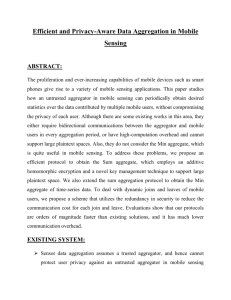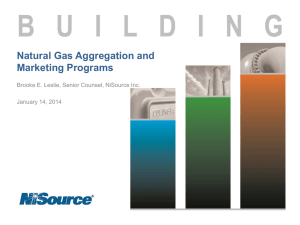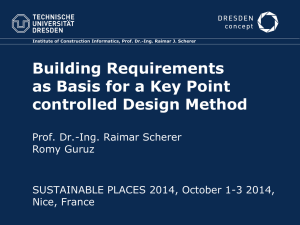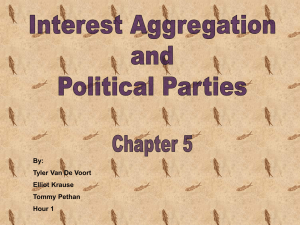ERF: Participating in aggregated projects
advertisement
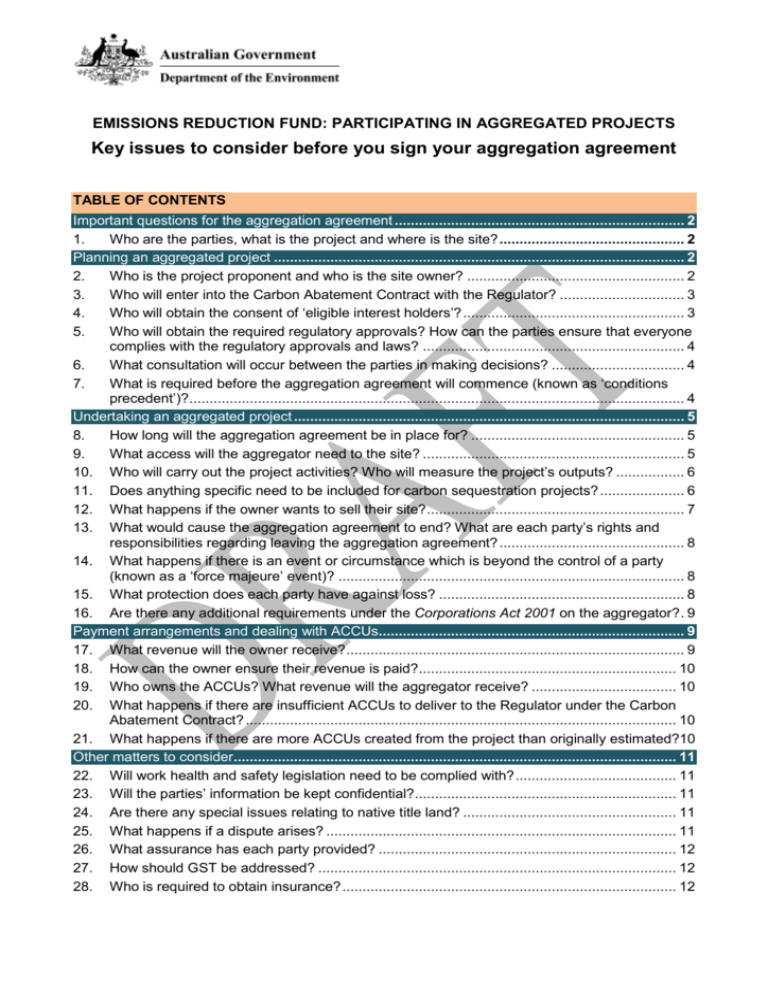
EMISSIONS REDUCTION FUND: PARTICIPATING IN AGGREGATED PROJECTS Key issues to consider before you sign your aggregation agreement TABLE OF CONTENTS Important questions for the aggregation agreement ........................................................................ 2 1. Who are the parties, what is the project and where is the site? .............................................. 2 Planning an aggregated project ...................................................................................................... 2 2. Who is the project proponent and who is the site owner? ...................................................... 2 3. Who will enter into the Carbon Abatement Contract with the Regulator? ............................... 3 4. Who will obtain the consent of ‘eligible interest holders’? ....................................................... 3 5. Who will obtain the required regulatory approvals? How can the parties ensure that everyone complies with the regulatory approvals and laws? ................................................................. 4 6. What consultation will occur between the parties in making decisions? ................................. 4 7. What is required before the aggregation agreement will commence (known as ‘conditions precedent’)? ........................................................................................................................... 4 Undertaking an aggregated project ................................................................................................. 5 8. How long will the aggregation agreement be in place for? ..................................................... 5 9. What access will the aggregator need to the site? ................................................................. 5 10. Who will carry out the project activities? Who will measure the project’s outputs? ................. 6 11. Does anything specific need to be included for carbon sequestration projects? ..................... 6 12. What happens if the owner wants to sell their site? ................................................................ 7 13. What would cause the aggregation agreement to end? What are each party’s rights and responsibilities regarding leaving the aggregation agreement? .............................................. 8 14. What happens if there is an event or circumstance which is beyond the control of a party (known as a ‘force majeure’ event)? ...................................................................................... 8 15. What protection does each party have against loss? ............................................................. 8 16. Are there any additional requirements under the Corporations Act 2001 on the aggregator? . 9 Payment arrangements and dealing with ACCUs............................................................................ 9 17. What revenue will the owner receive? .................................................................................... 9 18. How can the owner ensure their revenue is paid? ................................................................ 10 19. Who owns the ACCUs? What revenue will the aggregator receive? .................................... 10 20. What happens if there are insufficient ACCUs to deliver to the Regulator under the Carbon Abatement Contract? ........................................................................................................... 10 21. What happens if there are more ACCUs created from the project than originally estimated?10 Other matters to consider.............................................................................................................. 11 22. Will work health and safety legislation need to be complied with? ........................................ 11 23. Will the parties’ information be kept confidential? ................................................................. 11 24. Are there any special issues relating to native title land? ..................................................... 11 25. What happens if a dispute arises? ....................................................................................... 11 26. What assurance has each party provided? .......................................................................... 12 27. How should GST be addressed? ......................................................................................... 12 28. Who is required to obtain insurance? ................................................................................... 12 WHAT IS THIS GUIDANCE FOR? The guidance in this document covers participation in aggregated projects. An aggregated project is one that brings multiple sources of carbon abatement together into one project or auction bid. This guidance should be read in conjunction with the “Questions to ask your aggregator” fact sheet and the case studies in aggregation. Further guidance on aggregation projects can also be found on the Clean Energy Regulator’s website. This document has been developed to assist an owner of land, asset, building or facility (owner) who is considering participating in the Emissions Reduction Fund (ERF) through aggregation, to understand the purpose and potential consequences of legal arrangements generally included in an ‘aggregation agreement’. This guidance sets out important questions that an owner may want to consider before preparing and entering into an aggregation agreement. This document is not intended to be comprehensive and is provided for guidance purposes only. The information provided in this document is not legal advice. The Department recommends that anybody considering entering into an aggregation agreement for participation in the ERF should obtain their own independent legal advice. IMPORTANT QUESTIONS FOR THE AGGREGATION AGREEMENT 1. Who are the parties, what is the project and where is the site? Aggregation agreements will generally be between two parties. One party is the ‘aggregator’ who is, for the purposes of this document, the person who will sign the Carbon Abatement Contract with the Clean Energy Regulator (Regulator) to sell Australian Carbon Credit Units (ACCUs) generated by the project to the Australian Government. The other is the ‘owner’, who is the person who owns or has a legal interest in the land, building or facility which will be used for the project (for example the owner of a farm where trees will be planted to sequester carbon). This guidance will use the word ‘site’ to refer to the land, building or facility which the owner brings to the project. An aggregation agreement should set out the identities of the parties, the type of project that is proposed to be undertaken, the site of that project and the ERF crediting method that will relate to the proposed project. See the Department of Environment’s website for an explanation of the relevant methods. Case study examples For examples of clauses which set out this information, see the Case studies in aggregation: environmental plantings project (example clause 1) and Case studies in aggregation: industrial energy efficiency (example clause 1). PLANNING AN AGGREGATED PROJECT 2. Who is the project proponent and who is the site owner? The Regulator will only enter into a Carbon Abatement Contract with a party who is the ‘project proponent’ for the ERF project. This means that the aggregator will need to be the project proponent if the parties want the aggregator to contract with the Regulator. Note that the aggregator may not always be the proponent. For example, they may be a service provider who works for a proponent. The project proponent for an ERF project needs to have the legal right to undertake the project and is responsible for carrying out the project. Further information regarding legal right to carry out a project can be found on the legal right section of the Regulator’s website. 2 Because the aggregator will be the project proponent in these examples, the legal right to carry out the project needs to be specifically transferred to the aggregator from the owner (or any other person who has the legal right, such as an asset owner or a lessee). This would usually be done in the aggregation agreement between the parties but could also be done though a letter from the owner to the aggregator confirming the transfer of this right. It will be important for the aggregator to be able to demonstrate to the Regulator that they have the legal right to carry out the project and that right will remain in place for the life of the crediting period of the project. Proponents can have their service provider get legal right from owners, then pass on that legal right to the proponent. It is also possible to have multiple project proponents and, in that case, both the aggregator and the owner can choose to be project proponents. In this scenario, it will still need to be made clear, through appropriate documentation (such as an agreement or letter), that both parties have the necessary legal right and responsibility to undertake the project. Where there are multiple project proponents, it is possible for one or all of the project proponents to enter into a Carbon Abatement Contract with the Regulator. Case study examples For an example of a clause transferring the legal right in an aggregation agreement, see the Case studies in aggregation: environmental plantings project (example clauses 1 and 4) and Case studies in aggregation: industrial energy efficiency (example clauses 1 and 4). 3. Who will enter into the Carbon Abatement Contract with the Regulator? If the project proponent for the aggregation project is the aggregator, the aggregator will enter into the Carbon Abatement Contract with the Regulator. If the owner and aggregator are both project proponents for the project (under the multiple project proponent option), then both or one of them can enter the Carbon Abatement Contract with the Regulator. Only the party who enters the Carbon Abatement Contract with the Regulator will be bound by its terms (i.e. to deliver ACCUs in accordance with the delivery schedule). 4. Who will obtain the consent of ‘eligible interest holders’? For carbon sequestration projects, the consent of the ‘eligible interest holders’ must be obtained by the project proponent in the way the Regulator requires. Eligible interest holders include persons who hold an applicable carbon sequestration right and may include site or asset owners (if the owner is renting or leasing the site or asset), banks holding a mortgage over the land, State or Territory Ministers (where the land is Crown Land) and registered native title body corporations (if the land is native title land) [LINK ON CS right]. The consent of the eligible interest holders can be obtained after the project has been registered but must be obtained before the end of the first reporting period for the project. However, if the aggregator does not get the relevant consents before registering the project, then the project cannot be fully approved (‘declared’) until the consents are finalised. It may be prudent to obtain the consent of the eligible interest holders before the project is registered, to ensure that the project can proceed as soon as registration has been achieved. The parties will need to decide who will obtain the consent of the eligible interest holders. If this obligation is placed on the aggregator, it may be necessary for the owner to provide assistance to the aggregator to obtain these consents. For example, the owner may need to approach its bank if there is a mortgage over the land. Case study examples 3 For an example of a clause covering the obtaining of the consent of the eligible interest holders, see the Case studies in aggregation: environmental plantings project (example clause 5.1). 5. Who will obtain the required regulatory approvals? How can the parties ensure that everyone complies with the regulatory approvals and laws? All projects will need to have the applicable regulatory approvals to carry out the project under Commonwealth, State or Territory law, including local/municipal law, like Local Government Area planning ordinances. The regulatory approvals may include planning or environmental permits or consents. Regulatory approvals can be obtained after the project has been registered but must be obtained before the end of the first reporting period for the project. The parties will need to consider whether the regulatory approvals will be sought before or after project registration and who will be responsible for obtaining them. It will be usual for there to be an obligation in the aggregation agreement that both parties need to comply with any relevant laws. These laws could be defined in the agreement (i.e. to include occupational health and safety or environmental laws) or the drafting could incorporate all laws. Case study examples For an example of a clause covering obtaining regulatory approvals or complying with laws, see the Case studies in aggregation: environmental plantings project (example clause 5.1) and Case studies in aggregation: industrial energy efficiency (example clause 5.1). 6. What consultation will occur between the parties in making decisions? If there needs to be ongoing liaison between the parties in relation to implementation or operation of the project, the parties may wish to include a good faith clause in the aggregation agreement requiring them to consult with each other in terms of any decisions that need to be made. It is likely that such a clause would be beneficial for carbon sequestration projects, which cover a significant time frame (25 or 100 years). It will also be useful to include a dispute resolution clause in the aggregation agreement which includes steps to follow if consultation and negotiation between the parties is not effective. For further information on dispute resolution provisions see Question 25. There may be situations where the aggregator needs the owner to notify them about changes in relation to the project. For example, if an owner is already part of another ERF project or is operating under one of the government programmes excluded by CFI legislation (for excluded programmes see the government programme requirement section of the Regulator’s website). The parties may wish to include a clause in the aggregation agreement requiring the parties to notify each other of matters which might reasonably impact on the eligibility or operation of the project. Case study examples For an example of a consultation clause, see the Case studies in aggregation: environmental plantings project (example clause 7) and Case studies in aggregation: industrial energy efficiency (example clause 7). 7. What is required before the aggregation agreement will commence (known as ‘conditions precedent’)? The owner may wish to have the aggregator achieve certain steps before the aggregation agreement takes effect. For example, obtaining project registration or securing a Carbon Abatement Contract with the Regulator. The owner should note that registering a project imposes certain obligations which cannot be ignored if the project does not obtain a Carbon Abatement Contract. It is also possible that the aggregator may wish the owner to do something before the aggregation agreement takes effect. For example, the aggregator may need information about the owner’s 4 building or facility so it can understand its current energy use and determine what energy efficiency opportunities may be available. The parties will need to be careful, however, that the project does not ‘begin to be implemented’ before the Regulator has registered the project, as this may cause the project to fail the newness eligibility requirement. Some activities can be done without the project being seen as starting, like planning or designing the project. However, other activities will be seen as the project starting, like starting construction works. More information can be found on the newness section of the Regulator’s website. Case study examples For an example of a condition precedent clause, see the Case studies in aggregation: environmental plantings project (example clause 2) and Case studies in aggregation: industrial energy efficiency (example clause 2). UNDERTAKING AN AGGREGATED PROJECT 8. How long will the aggregation agreement be in place for? The period during which the aggregation agreement will be in place depends on a number of things. The aggregation agreement needs to be in place for a period which matches the term of the crediting period. Additionally, the parties should consider if any additional time, after the crediting period has finished, is required in order to complete reporting and for auditors to check on the project. An agreement may commence before a project is registered or the crediting period starts. For example, it may be that a short term Carbon Abatement Contract relating to an emissions avoidance project is entered into by the aggregator for a period of less than seven years. In these circumstances, the crediting period will still be seven years, and the parties may wish to therefore have the agreement last for at least seven years. See Question 11 for specific requirements regarding the term of aggregation agreements for carbon sequestration projects. 9. What access will the aggregator need to the site? The aggregator (or its contractors, such as equipment suppliers or auditors) may need to access the site to carry out its obligations under the aggregation agreement, CFI legislation and relevant method for the full term of the aggregation agreement. Other people may also have an interest in access to the site. For example, if the owner is leasing the site, then the person leasing it to them may need to also agree to rules about access. You may want to list the particular activities that the aggregator will need access to the site for. For example, for the purpose of undertaking audits, ensuring equipment is still in place, replacing malfunctioning equipment or monitoring the growth of trees. For more information about what activities are required under your method, you can look on the Department of the Environment website. Alternatively, an aggregator may only need access to the site to conduct an audit. Where the site for the project is only a part of the owner’s property, it will be appropriate to agree on the route by which the aggregator will access the site. An owner may also consider it appropriate to restrict the hours of access and the times when the aggregator may perform its services. This may be particularly important for the owner in an energy efficiency project if the owner intends to continue to operate its facility during the project works or is required to cease operating its facility during the works. It is usual for such access to be granted by way of a licence. It should also be acknowledged that access may be required by the Regulator through its auditors or inspectors at any time, in accordance with their legislated authority. 5 At the end of the aggregation agreement, the parties will need to consider if it is reasonable and/or appropriate for any of the machinery, plant or equipment to remain on the site. Case study examples For an example of an access clause, read the Case studies in aggregation: environmental plantings project (example clause 3) and Case studies in aggregation: industrial energy efficiency (example clause 3). Who will carry out the project activities? Who will measure the project’s outputs? 10. It is important that the aggregation agreement clearly sets out which party will be responsible for every step required to carry out the project in compliance with the Carbon Credits (Carbon Farming Initiative) Act 2011 (Act) and associated rules and regulations and the method applicable to the project. For example, the following are the primary steps that should be allocated to a party, although there may be many more: securing all necessary regulatory approvals. For carbon sequestration projects, securing the consent of all eligible interest holders. registering the project as an eligible offsets project. carrying out the project in accordance with the relevant method and the CFI legislation. measuring or monitoring the abatement in accordance with the requirements of the relevant method. preparing an offsets report, including providing data to each other to enable the preparation of this report. commissioning any audits. obtaining a certificate of entitlement. opening an Australian National Registry of Emissions Units account. Additionally, the parties should consider who will pay the costs for each of these steps. Case study examples For an example of a clause covering the parties’ obligations, see the Case studies in aggregation: environmental plantings project (example clauses 4-7) and Case studies in aggregation: industrial energy efficiency (example clauses 4-7). 11. Does anything specific need to be included for carbon sequestration projects? Carbon sequestration projects have a permanence period, which can be 25 or 100 years. This means the carbon must continue to be stored for this time period. Accordingly, the parties will need to be comfortable that the obligations, particularly those that relate to maintenance and reporting, will run for that same period of time. Consequences may arise if a loss of carbon in a carbon sequestration project happens during the permanence period because of a ‘natural disturbance’, the actions of someone not doing the project (‘third party’), or any other cause. This might involve the Regulator serving the project proponent with a relinquishment notice or placing a carbon maintenance obligation on all, or part of, the project land. Natural disturbances include flood, bushfire, drought, pest attack and disease. For the Regulator to issue a relinquishment notice there must be: a ‘significant reversal’ of the carbon stored by the project caused by a natural disturbance (loss of the stored carbon occurs on at least 5 percent of the project area); or 6 a ‘significant reversal’ of the carbon stored by the project caused by third party conduct (loss of the stored carbon occurs on at least 5 percent of the project area, or 50 hectares of the area, whichever is smaller). Regardless of the cause of the reversal, a relinquishment notice can be issued if the Regulator is not satisfied that reasonable steps have been taken within a reasonable period to mitigate the effect of the natural disturbance or conduct. It will be important for aggregation agreements covering carbon sequestration aggregation projects to specify where liability falls in the event of a significant reversal, noting that if a significant reversal leads to a relinquishment notice, the notice will be served on the project proponent. The owner may therefore want to require the aggregator to comply with the terms of any relinquishment notice. In turn, the owner should be aware that the aggregator may seek a contribution from the owner for the costs of complying with the notice. The aggregator may also seek to require the owner to not do anything which could lead to a significant reversal. They may require that the owner do actions within a reasonable period of time to counteract the effect of any losses from natural disturbances or third party conduct. If a relinquishment notice is not complied with, the Regulator may impose a carbon maintenance obligation on the owner’s land. A carbon maintenance obligation is used to prevent action that results, or is likely to result, in a further reduction in carbon stores below the amount stored on the land at the time the carbon maintenance obligation was declared. If a carbon maintenance obligation is placed on the owner’s land, the owner may want the aggregator to ensure the owner is not responsible for any costs associated with complying with the carbon maintenance obligation. For more information about carbon maintenance obligations and relinquishment notices, see the permanence section of the Regulator’s website. Case study examples For an example that is appropriate for an aggregation agreement relating to carbon sequestration projects, see the Case studies in aggregation: environmental plantings project (example clause 11). 12. What happens if the owner wants to sell their site? If an owner wants to sell the site, the owner and aggregator will need to agree on whether the site would be removed from the project or whether it would stay in the project. If the site stays in the project, the aggregator is likely to want the new owner to be bound by the same terms and conditions set out in the aggregation agreement it has with the current owner. In particular, the aggregator will want to ensure that it has a continuous legal right to carry out the project, regardless of the change in ownership of the site. If the aggregator is going to lose income because the site leaves the project, they may consider asking the owner to cover those losses. For carbon sequestration projects, if an owner wishes to sell the site, then it is likely that the parties will agree that the property needs to remain in the project (because of the relinquishment requirements which may arise – see next paragraph). Potential new owners will also need to be made aware of any relevant permanence requirements before buying the property. If an owner in a carbon sequestration project wants to completely remove the site from the project, or a new owner does not want the site to remain in the project, a relinquishment requirement may arise. This relinquishment requirement would apply to the aggregator as the project proponent. The aggregator is therefore likely to want the owner to reimburse it for the costs of complying with a relinquishment notice in these circumstances. It will be important for owners entering into aggregation agreements for carbon sequestration projects to understand the commitment they are making. In particular, it is important for an 7 owner to understand the need to ensure that the sequestered carbon is stored for the relevant permanence period (either 25 or 100 years). Owners may also want to discuss what would happen if they wanted to sell equipment that is part of the project. For more information about relinquishment notices, see the ACCUs page of the Regulator’s website. Case study examples For an example of a clause relating to the sale of a site during the project period, see the Case studies in aggregation: industrial energy efficiency (example clause 14). 13. What would cause the aggregation agreement to end? What are each party’s rights and responsibilities regarding leaving the aggregation agreement? In addition to the sale of a site, there may be other events which could result in the aggregation agreement ending. Such events could include a default by one of the parties which is not remedied within a reasonable period of time, or the insolvency or bankruptcy of the owner or aggregator. If a default leads to termination of the aggregation agreement, the parties will need to consider whether any compensation would be paid by the defaulting party to the non-defaulting party. The parties will also need to consider whether they want the ability for the aggregation agreement to come to an end by mutual agreement. In these circumstances and depending upon the point in the project life, the aggregator will need to consider how it will source alternative ACCUs in order to satisfy its delivery obligations under the Carbon Abatement Contract and for carbon sequestration projects to comply with any relinquishment notices. Case study examples For an example of a termination clause, see the Case studies in aggregation: environmental plantings project (example clause 12) and Case studies in aggregation: industrial energy efficiency (example clause 15). 14. What happens if there is an event or circumstance which is beyond the control of a party (known as a ‘force majeure’ event)? It is usual to include provisions in agreements relating to doing a project to cover a ‘force majeure’ event. A ‘force majeure’ event is an event outside the control of a party to the aggregation agreement. The provisions may allow the party who is affected by the ‘force majeure’ event to attempt to deal with the event. If it is not possible to stop the event, then the obligations within the aggregation agreement may be put on hold for a specified period. If the event will have a long term impact on the project being undertaken, it may be necessary to terminate the aggregation agreement. Case study examples For an example of a force majeure clause, see the Case studies in aggregation: environmental plantings project (example clause 11). 15. What protection does each party have against loss? The parties will need to give consideration to how project risks are shared between them and what will happen in the event that there is a loss in connection with the project. For example, if during its access of the site, the aggregator damages the owner’s belongings, then the owner will want to ensure that it can recover the costs of this damage from the aggregator. Or, if the owner’s actions mean the project does not abate as much carbon as expected, the aggregator may expect the owner to reimburse it for the lost revenue that this causes. 8 Case study examples For an example of an indemnity clause, see the Case studies in aggregation: environmental plantings project (example clauses 8 and 10-11) and Case studies in aggregation: industrial energy efficiency (example clauses 8 and 12). 16. Are there any additional requirements under the Corporations Act 2001 on the aggregator? Aggregators are likely to need to comply with regulatory requirements under the Corporations Act 2001. Aggregation agreements themselves will, in some circumstances, be ‘financial products’. An aggregated project will, in some circumstances, be a ‘managed investment scheme’. Businesses that provide ‘financial services’ in relation to ‘financial products’ may need to hold an Australian financial services licence (AFS licence). The aggregator may also be required to give the owner a Financial Services Guide and a Product Disclosure Statement. The aggregator should be aware of financial regulation that may apply to them and their proposed arrangements, and where necessary must hold an AFS licence unless exempt. To find out whether an aggregator holds such a licence, check the Australian Securities and Investments Commission (ASIC) register. Owners may want to ask the aggregator for written advice saying that the aggregator is following the rules set out in the Corporations Act 2001. Examples of how this might be done are provided in the Case studies in aggregation: environmental plantings project and Case studies in aggregation: industrial energy efficiency. Further information about AFS licensing and carbon markets can also be found on the carbon markets page of ASIC’s website. PAYMENT ARRANGEMENTS AND DEALING WITH ACCUS 17. What revenue will the owner receive? The parties will need to consider when the owner will be paid by the aggregator and in what form. Payments can be cash or in-kind. Cash payment amounts could include a: fixed amount over the life of the project; fixed amount for each ACCU created; or percentage amount based on the sale price of the ACCU (taking into account the confidentiality rules in the Carbon Abatement Contract). Payment times could include: monthly or yearly dates; upon creation of ACCUs; or after sale of ACCUs. As an aggregator will not be paid by the Regulator under a Carbon Abatement Contract until the ACCUs have been delivered to the Regulator, the aggregator may only wish to pay the owner after it has been paid by the Regulator. ACCUs can be created every 6 months, or where a particular abatement claim is for 2,000 tonnes of carbon dioxide equivalent or more, as frequently as every month. Alternatively, the parties may agree that the owner will not be paid a fee but will, instead, receive value in-kind. For example, in an energy efficiency project, the aggregator may undertake all of the works for the project including installation of the equipment and providing the new equipment at a 9 discounted cost. In this case, the value which will be received by the owner will be the savings they make on the new equipment and the expected reduction in energy costs. The way owners are paid may affect whether an aggregated project is regulated under the Corporations Act 2001 (see Question 16 above). 18. How can the owner ensure their revenue is paid? The owner may wish to research the aggregator so that the owner is comfortable that the aggregator has the financial resources to undertake the project and to pay the owner. This is important because the aggregator will not receive payment under the Carbon Abatement Contract until after the ACCUs are delivered to the Regulator. For further information, see the “Questions to ask your aggregator” fact sheet: [LINK] If the owner wishes to make sure that they will be paid, they could ask the aggregator to provide them with some form of security, such as a bank guarantee. The security can also give comfort to the owner that they will get back some funds (of an agreed amount) if the aggregator is unable to complete the project or, in carrying out the project, there is damage to the site or the owner otherwise suffers loss due to the aggregator’s default under the aggregation agreement. 19. Who owns the ACCUs? What revenue will the aggregator receive? The ACCUs will be issued into the Australian National Registry of Emissions Units account held by the project proponent or, if there are multiple project proponents, the nominee. If the aggregator is the only project proponent for an aggregation project, they will receive the ACCUs. If the aggregator has a Carbon Abatement Contract with the Regulator, the aggregator will then deliver these ACCUs to the Regulator in accordance with the terms of the Contract. It is only after the aggregator has delivered the ACCUs to the Regulator that the Regulator will pay the aggregator. If the owner will be paid a percentage share of the ACCUs, it will be important for the aggregation agreement to include an obligation on the aggregator to pass through the owner’s percentage. The owner may want the aggregation agreement to specify that the owner holds an equitable interest in the ACCUs to cover this percentage. 20. What happens if there are insufficient ACCUs to deliver to the Regulator under the Carbon Abatement Contract? The parties may want to consider what arrangements will apply if the project does not create enough ACCUs to comply with the delivery obligations under the Carbon Abatement Contract. If the project creates ACCUs at a slower rate than was estimated in the project’s delivery schedule, the aggregator can seek to renegotiate the delivery schedule with the Regulator. If the ACCUs cannot be delivered at all, the person who signed the Carbon Abatement Contract would have to buy ACCUs from other projects as compensation to the Regulator (‘make good’). It will be important for the parties to consider who should bear the responsibility for payment of any market damages which may arise under the Carbon Abatement Contract and have this documented in the aggregation agreement to avoid any dispute in the future. It would usually be expected that the aggregator would be responsible for market damages. The aggregator may want the ability to recover all or part of the market damages from the owner if it was the owner’s actions that led to market damages being incurred. 21. What happens if there are more ACCUs created from the project than originally estimated? The parties may also want to consider what arrangements will apply if more ACCUs are created from the project than originally estimated. For example, the parties may want to consider whether the payment arrangements for the extra ACCUs will be the same as for the estimated volume, whether the aggregator will be entitled to retain all revenue generated from excess ACCUs or whether there should be a different payment regime to cover the extra ACCUs. 10 Case study examples If an owner is not otherwise receiving any payment from an aggregator (such as in the Case studies in aggregation: industrial energy efficiency example clause 13), the owner may wish to receive an additional or premium payment for these excess ACCUs. OTHER MATTERS TO CONSIDER 22. Will work health and safety legislation need to be complied with? As with any commercial activity, work health and safety laws that apply must be followed. The primary responsibility of complying with applicable work health and safety legislation and requirements will normally rest with the party who is physically undertaking the project. In some circumstances, however, the obligations may be placed on the owner, the aggregator and any service provider. The application of work health and safety laws to multiple parties working on the same site can be complex. For example, the parties may be within the parameters of concurrent duty holders under the Model Work Health and Safety Act (which can be found on the publications page of Safe Work Australia’s website) and may be obliged to consult with each other in order to comply with that law. An owner should review the application of the applicable work, health and safety law to its own circumstances and in the jurisdiction of the project and seek their own independent legal advice on options for dealing with this responsibility in the aggregation agreement. For more information see the Safe Work Australia website. Case study examples For an example work health and safety clause, see the Case studies in aggregation: industrial energy efficiency (example clause 17). 23. Will the parties’ information be kept confidential? The parties will need to consider whether they want the information covered in the aggregation agreement to be kept confidential. In particular, both parties may prefer that the payment terms are not disclosed to external parties, unless such disclosure is required by law. It is relevant to note that the Carbon Abatement Contract imposes an obligation to keep the price of ACCUs confidential, subject to certain exceptions. In exchange for the aggregator, as a party to the contract, being permitted by the Regulator to disclose the ACCU price under the contract to the owner, the owner may be required to enter into a price confidentiality agreement with the Regulator. Some methods specifically require the sharing of commercial data as a reporting requirement. If this is the case, the parties should discuss how this information should be shared and may seek to impose a data sharing obligation on each other as part of their obligations in carrying out the project. 24. Are there any special issues relating to native title land? There are specific provisions in the CFI Act and associated regulations concerning land rights and native title land [LINK]. If an aggregated project will be undertaken on this type of land, the parties will need to consider what additional clauses may need to be included in the aggregation agreement. 25. What happens if a dispute arises? The aggregation agreement should include steps to follow in the event of a dispute arising between the parties. 11 A dispute resolution clause in an aggregation agreement may involve the parties trying to resolve the dispute through negotiation, followed by a more formal mechanism such as mediation, arbitration or enforceable undertaking. 26. What assurance has each party provided? It is standard practice in aggregation agreements such as these for each party to provide the other with representations and warranties as to their ability to enter into the agreement and to carry out their obligations under the agreement. For example, a warranty for a private company might mean that the company has all the approvals it needs and is not in liquidation. These should be appropriate having regard to the particular circumstances of the parties and the project. Case study examples For an example of a warranty clause, see the Case studies in aggregation: industrial energy efficiency (example clause 10). 27. How should GST be addressed? A standard GST clause allowing for the increase in the amount of payments to include GST should be included in the aggregation agreement. The application of the A New Tax System (Goods and Services Tax) Act 1999 to aggregation arrangements can be complex and the Department recommends that the parties obtain their own independent legal and taxation advice on the application of this legislation to their proposed arrangements. 28. Who is required to obtain insurance? It is likely that the owner will want the aggregator to hold appropriate insurance to cover the project and the specific activities that will be undertaken on the site. The owner may also wish to consider whether its own existing insurance for the site and its own activities will be sufficient for the project. © Copyright Commonwealth of Australia, 2015. Emissions Reduction Fund: Participating in Aggregated Projects is licensed by the Commonwealth of Australia for use under a Creative Commons Attribution 4.0 Australia licence with the exception of the Coat of Arms of the Commonwealth of Australia, the logo of the agency responsible for publishing the report, content supplied by third parties, and any images depicting people. For licence conditions see: https://creativecommons.org/licenses/by/4.0/ This report should be attributed as ‘Emissions Reduction Fund: Participating in Aggregated Projects, Commonwealth of Australia 2015’. 12
